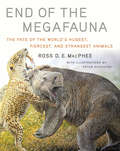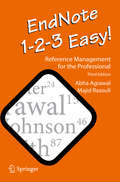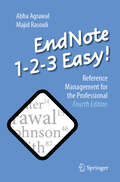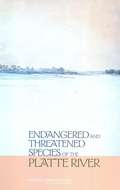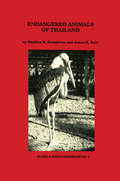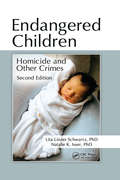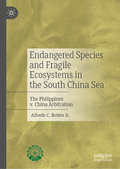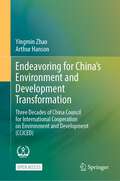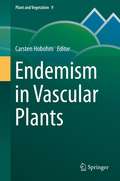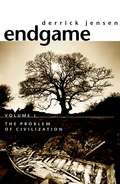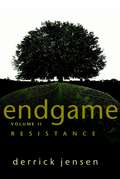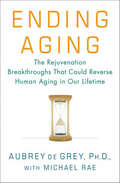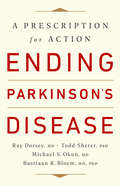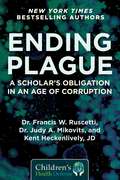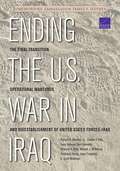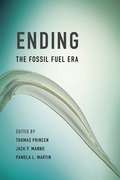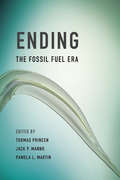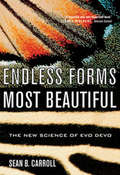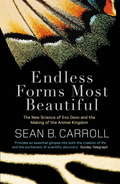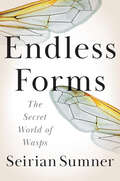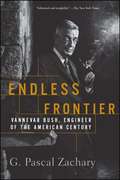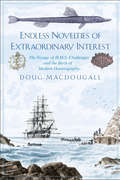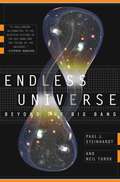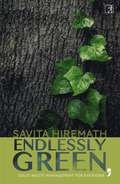- Table View
- List View
End of the Megafauna: The Fate Of The World's Hugest, Fiercest, And Strangest Animals
by Peter Schouten Ross D MacPheeThe fascinating lives and puzzling demise of some of the largest animals on earth. Until a few thousand years ago, creatures that could have been from a sci-fi thriller—including gorilla-sized lemurs, 500-pound birds, and crocodiles that weighed a ton or more—roamed the earth. These great beasts, or “megafauna,” lived on every habitable continent and on many islands. With a handful of exceptions, all are now gone. What caused the disappearance of these prehistoric behemoths? No one event can be pinpointed as a specific cause, but several factors may have played a role. Paleomammalogist Ross D. E. MacPhee explores them all, examining the leading extinction theories, weighing the evidence, and presenting his own conclusions. He shows how theories of human overhunting and catastrophic climate change fail to account for critical features of these extinctions, and how new thinking is needed to elucidate these mysterious losses. Along the way, we learn how time is determined in earth history; how DNA is used to explain the genomics and phylogenetic history of megafauna—and how synthetic biology and genetic engineering may be able to reintroduce these giants of the past. Until then, gorgeous four-color illustrations by Peter Schouten re-create these megabeasts here in vivid detail.
EndNote 1-2-3 Easy!: Reference Management for the Professional
by Abha Agrawal Majid RasouliThis book is intended for healthcare professionals, biomedical researchers, health policy experts, and graduate students who frequently write and publish scientific manuscripts in peer reviewed journals. This new edition updates earlier versions with an emphasis on the most currently available Clarivate Analytics software application EndNote X9, a widely used reference management software. For first-time users of EndNote X9, this book is a comprehensive and well-illustrated instruction manual for getting started, including detailed instructions on installation, creating reference libraries, and ultimately creating complete and accurate citation-based bibliographies necessary to achieve successful peer reviewed publications. There is also a full chapter devoted to careful guidance for the growing practice of citing references from online internet sources. For existing “power users” of current and earlier versions of EndNote, this book provides quick and easy access to a comprehensive compendium of nuanced and advanced features of this powerful software, with an emphasis on providing greater ease and control in coordinating and curating research materials and bibliographies with research collaborators and scientific writing teams. The authors have also added new, state-of-the-art “how-to” guidance on a variety of methods of using EndNote, including PubMed, Google Scholar, Web of Science, Scopus and others. Like many legacy software systems, Clarivate Analytics has also begun to offer an online “desktop” version of EndNote, a topic which is now also covered in Chapter 10 (EndNote Online) of this new edition.
EndNote 1-2-3 Easy!: Reference Management for the Professional
by Abha Agrawal Majid RasouliThis book is intended for students, academics, authors, and research-oriented professionals to store, organize, and manage their references for research papers, theses, dissertations, journal articles, and other publications. Its purpose is to educate readers about effective use of information technology in reference management - the process of storing, managing, retrieving and citing scientific references. It also provides step-by-step instruction on using EndNote, a popular reference management software. Since the publication of the third edition, substantial changes have taken place in the field of reference management. EndNote has released a new version – EndNote 20. The web-based knowledge databases such as Web of Science Core Collection, Scopus, and Google Scholar are also being used far more frequently. The fourth edition of EndNote 1-2-3 Easy! incorporates updated instructions and screenshots to ensure that the readers continue to find this a user-friendly book providing accurate and reliable information. For first-time users of EndNote 21, this book is a comprehensive and well-illustrated instruction manual for getting started, including detailed instructions on installation, creating reference libraries, and ultimately creating complete and accurate citation-based bibliographies necessary to achieve successful peer reviewed publications. For existing “power users” of current and earlier versions of EndNote, this book provides quick and easy access to a comprehensive compendium of nuanced and advanced features of this powerful software, with an emphasis on providing greater ease and control in coordinating and curating research materials and bibliographies with research collaborators and scientific writing teams.
Endangered And Threatened Species Of The Platte River
by Committee on Endangered Threatened Species in the Platte River BasinThe tension between wildlife protection under the Endangered Species Act and water management in the Platte River Basin has existed for more than 25 years. The Platte River provides important habitat for migratory and breeding birds, including three endangered or threatened species: the whooping crane, the northern Great Plains population of the piping plover, and the interior least tern. The leading factors attributed to the decline of the cranes are historical overhunting and widespread habitat destruction and, for the plovers and terns, human interference during nesting and the loss of riverine nesting sites in open sandy areas that have been replaced with woodlands, sand and gravel mines, housing, and roadways. Extensive damming has disrupted passage of the endangered pallid sturgeon and resulted in less suitable habitat conditions such as cooler stream flows, less turbid waters, and inconsistent flow regimes. Commercial harvesting, now illegal, also contributed to the decline of the sturgeon. Endangered and Threatened Species of the Platte River addresses the habitat requirements for these federally protected species. The book further examines the scientific aspects of the U.S. Fish and Wildlife Service’s instream-flow recommendations and habitat suitability guidelines and assesses the science concerning the connections among the physical systems of the river as they relate to species’ habitats.
Endangered Animals of Thailand
by Stephen R. HumphreyThis work presents the state of knowledge on the endangered and threatened species of Thailand. Its pragmatic purpose is to improve Thailand’s future by providing access to technical guidance for planning development projects or other land-use changes. This information also should stimulate naturalists, professional biologists, or anyone who wishes to learn about the status of animals in Thailand. Which species are now on the brink of extinction from Thailand, and why? How can the Thai people reorganize themselves to reverse the course of destruction? Can ways be found for both the people and the rest of the fauna to prosper? Another purpose is to present a case study of the effects of longterm development for human use on the biological diversity of a tropical country.
Endangered Children: Homicide and Other Crimes, Second Edition
by Lita Linzer Schwartz Natalie K. IsserFrom infancy onward, children are in danger from many sources, including parental and sibling abuse, drug abuse and mental illness in the home, parental neglect, and poverty. Removing an at-risk child from a troubled environment brings on a host of new concerns and is not always a panacea. Endangered Children: Homicide, and Other Crimes, Second Edi
Endangered Species and Fragile Ecosystems in the South China Sea: The Philippines v. China Arbitration
by Alfredo C. Robles, Jr.This book presents an in-depth analysis of the environmental issues raised in the South China Sea Arbitration Awards, which have not attracted as much attention in the Philippines as the “nine-dash line”. Specifically it focuses on the conservation of endangered species and the conservation of fragile ecosystems in the South China Sea. The aims of the book are two-fold. First, it seeks to explain the Philippine perspective on the environmental aspects of its dispute with China. The book reconstructs the Philippine perspective in part by consulting several dozens of the hundreds of documents that the Philippines submitted to the Tribunal. Some of these documents were classified as secret and would thus have never been made available to the public had it not been for the arbitration. Second, it attempts to explain the decisions of the Tribunal on jurisdiction and admissibility as well as the decisions on the merits of the dispute. The book does this by consulting not only the two Awards but also the hundreds of pages of transcripts, expert reports, supplemental submissions and written responses by the Philippines to questions posed by the Tribunal.
Endeavoring for China’s Environment and Development Transformation: Three Decades of China Council for International Cooperation on Environment and Development (CCICED)
by Yingmin Zhao Arthur HansonThis is an open access book. CCICED has been woven into the fabric of China’s environmental development for the past 30 years—the length of an entire generation. It is also consistent with the most rapid modernization shift of the nation’s economy–environment relationship. This report provides insights into how CCICED operates and its success stories. It also presents a general picture of how changes of China in environmental development have taken place. CCICED at 30 is therefore a helpful account for future directions of sustainable environment.
Endemism in Vascular Plants
by Carsten HobohmThe book is the first comprehensive analysis of the macroecology and geobotany of endemic vascular plants with case-studies and analyses from different regions in the world. Endemism is a pre-extinction phenomenon. Endemics are threatened with extinction. Due to international nature conservation policies and due to the perception of the public the concept's importance is increasing. Endemism can result from different biological and environmental processes. Depending on the process conservation measures should be adapted. Endemic vascular plant taxa, in the setting of their species composition and vegetation types are important features of landscapes and indicators of the quality of relating habitats. The book is an important basis for biologists, ecologists, geographers, planners and managers of nature reserves and national parks, and people generally interested in nature conservation and biogeography of vascular plants.
Endgame, Volume 1: The Problem of Civilization
by Derrick JensenThe long-awaited companion piece to Derrick Jensen's immensely popular and highly acclaimed works A Language Older Than Words and The Culture of Make Believe. Accepting the increasingly widespread belief that industrialized culture inevitably erodes the natural world, Endgame sets out to explore how this relationship impels us towards a revolutionary and as-yet undiscovered shift in strategy. Building on a series of simple but increasingly provocative premises, Jensen leaves us hoping for what may be inevitable: a return to agrarian communal life via the disintegration of civilization itself.
Endgame, Volume 2: Resistance
by Derrick JensenWhereas Volume 1 of Endgame presents the problem of civilization, Volume 2 of this pivotal work illustrates our means of resistance. Incensed and hopeful, impassioned and lucid, Endgame leapfrogs the environmental movement's deadlock over our willingness to change our conduct, focusing instead on our ability to adapt to the impending ecological revolution.
Ending Aging: The Rejuvenation Breakthroughs That Could Reverse Human Aging in Our Lifetime
by Aubrey de Grey Michael RaeMUST WE AGE? A long life in a healthy, vigorous, youthful body has always been one of humanity's greatest dreams. Recent progress in genetic manipulations and calorie-restricted diets in laboratory animals hold forth the promise that someday science will enable us to exert total control over our own biological aging. Nearly all scientists who study the biology of aging agree that we will someday be able to substantially slow down the aging process, extending our productive, youthful lives. Dr. Aubrey de Grey is perhaps the most bullish of all such researchers. As has been reported in media outlets ranging from 60 Minutes to The New York Times, Dr. de Grey believes that the key biomedical technology required to eliminate aging-derived debilitation and death entirely—technology that would not only slow but periodically reverse age-related physiological decay, leaving us biologically young into an indefinite future—is now within reach.In Ending Aging, Dr. de Grey and his research assistant Michael Rae describe the details of this biotechnology. They explain that the aging of the human body, just like the aging of man-made machines, results from an accumulation of various types of damage. As with man-made machines, this damage can periodically be repaired, leading to indefinite extension of the machine's fully functional lifetime, just as is routinely done with classic cars. We already know what types of damage accumulate in the human body, and we are moving rapidly toward the comprehensive development of technologies to remove that damage. By demystifying aging and its postponement for the nonspecialist reader, de Grey and Rae systematically dismantle the fatalist presumption that aging will forever defeat the efforts of medical science.
Ending Parkinson's Disease: A Prescription for Action
by Michael S. Okun Ray Dorsey Todd Sherer Bastiaan R. BloemIn this "must-read" guide (Lonnie Ali), four leading doctors and advocates offer a bold action plan to prevent, care for, and treat Parkinson's disease-one of the great health challenges of our time. Brain diseases are now the world's leading source of disability. The fastest growing of these is Parkinson's: the number of impacted patients has doubled to more than six million over the last twenty-five years and is projected to double again by 2040. Harmful pesticides that increase the risk of Parkinson's continue to proliferate, many people remain undiagnosed and untreated, research funding stagnates, and the most effective treatment is now a half century old.In Ending Parkinson's Disease, four top experts provide a plan to help prevent Parkinson's, improve care and treatment, and end the silence associated with this devastating disease.
Ending Plague: A Scholar's Obligation in an Age of Corruption (Children’s Health Defense)
by Judy Mikovits Kent Heckenlively Dr. Francis W. RuscettiFrom the authors of the New York Times bestselling Plague of Corruption comes the prescription on how to end the plague infecting our medical community.Ending Plague continues the New York Times bestselling team of Dr. Judy A. Mikovits and Kent Heckenlively with legendary scientist, Dr. Francis W. Ruscetti joining the conversation. Dr. Ruscetti is credited as one of the founding fathers of human retrovirology. In 1980, Dr. Ruscetti&’s team isolated the first pathogenic human retrovirus, HTLV-1. Ruscetti would eventually go on to work for thirty-eight years at the National Cancer Institute. Dr. Ruscetti was deeply involved in performing some of the most critical HIV-AIDS research in the 1980s, pioneered discoveries in understanding the workings of the human immune system in the 1990s, isolating a new family of mouse leukemia viruses linked to chronic diseases in 2009, and offers his insights into the recent COVID-19 pandemic. In 1991, Ruscetti received the Distinguished Service Award from the National Institutes of Health. Dr. Ruscetti offers a true insider&’s portrait of nearly four decades at the center of public health. His insights into the successes and failures of government science will be eye-opening to the general public. You will read never-before-revealed information about the personalities and arguments which have been kept from view behind the iron curtain of public health. Can we say our scientists are protecting us, or is another agenda at work? For most of his decades at the National Cancer Institute, Dr. Ruscetti has been in almost daily contact with his long-time collaborator, Dr. Mikovits, and their rich intellectual discussions will greatly add to our national discussion. Science involves a rigorous search for truth, and you will come to understand how science scholars are relentless in their quest for answers.
Ending The U.s. War In Iraq
by Ben Connable Terrence K. Kelly Charles P. Ries Richard R. Brennan Larry HanauerEnding the U. S. war in Iraq required redeploying 100,000 military and civilian personnel; handing off responsibility for 431 activities to the Iraqi government, U. S. embassy, USCENTCOM, or other U. S. government entities; and moving or transferring ownership of over a million pieces of property in accordance with U. S. and Iraqi laws, national policy, and DoD requirements. This book examines the planning and execution of this transition.
Ending the Fossil Fuel Era
by Thomas Princen Pamela L. Martin Jack P. MannoNot so long ago, people North and South had little reason to believe that wealth from oil, gas, and coal brought anything but great prosperity. But the presumption of net benefits from fossil fuels is eroding as widening circles of people rich and poor experience the downside.A positive transition to a post-fossil fuel era cannot wait for global agreement, a swap-in of renewables, a miracle technology, a carbon market, or lifestyle change. This book shows that it is now possible to take the first step toward the post-fossil fuel era, by resisting the slow violence of extreme extraction and combustion, exiting the industry, and imagining a good life after fossil fuels. It shows how an environmental politics of transition might occur, arguing for going to the source rather than managing byproducts, for delegitimizing fossil fuels rather than accommodating them, for engaging a politics of deliberately choosing a post-fossil fuel world. Six case studies reveal how individuals, groups, communities, and an entire country have taken first steps out of the fossil fuel era, with experiments that range from leaving oil under the Amazon to ending mountaintop removal in Appalachia.
Ending the Fossil Fuel Era
by Thomas Princen Pamela L. Martin Jack P. MannoNot so long ago, people North and South had little reason to believe that wealth from oil, gas, and coal brought anything but great prosperity. But the presumption of net benefits from fossil fuels is eroding as widening circles of people rich and poor experience the downside.A positive transition to a post-fossil fuel era cannot wait for global agreement, a swap-in of renewables, a miracle technology, a carbon market, or lifestyle change. This book shows that it is now possible to take the first step toward the post-fossil fuel era, by resisting the slow violence of extreme extraction and combustion, exiting the industry, and imagining a good life after fossil fuels. It shows how an environmental politics of transition might occur, arguing for going to the source rather than managing byproducts, for delegitimizing fossil fuels rather than accommodating them, for engaging a politics of deliberately choosing a post-fossil fuel world. Six case studies reveal how individuals, groups, communities, and an entire country have taken first steps out of the fossil fuel era, with experiments that range from leaving oil under the Amazon to ending mountaintop removal in Appalachia.
Ending the Fossil Fuel Era (The\mit Press Ser.)
by Thomas Princen Pamela L. Martin Jack P. MannoA provocative call for delegitimizing fossil fuels rather than accommodating them, accompanied by case studies from Ecuador to Appalachia and from Germany to Norway.Not so long ago, people North and South had little reason to believe that wealth from oil, gas, and coal brought anything but great prosperity. But the presumption of net benefits from fossil fuels is eroding as widening circles of people rich and poor experience the downside.A positive transition to a post-fossil fuel era cannot wait for global agreement, a swap-in of renewables, a miracle technology, a carbon market, or lifestyle change. This book shows that it is now possible to take the first step toward the post-fossil fuel era, by resisting the slow violence of extreme extraction and combustion, exiting the industry, and imagining a good life after fossil fuels. It shows how an environmental politics of transition might occur, arguing for going to the source rather than managing byproducts, for delegitimizing fossil fuels rather than accommodating them, for engaging a politics of deliberately choosing a post-fossil fuel world. Six case studies reveal how individuals, groups, communities, and an entire country have taken first steps out of the fossil fuel era, with experiments that range from leaving oil under the Amazon to ending mountaintop removal in Appalachia.
Endless Forms Most Beautiful: The New Science of Evo Devo
by Sean B. Carroll"A beautiful and very important book."--Lewis Wolpert, American Scientist For over a century, opening the black box of embryonic development was the holy grail of biology. Evo Devo--Evolutionary Developmental Biology--is the new science that has finally cracked open the box. Within the pages of his rich and riveting book, Sean B. Carroll explains how we are discovering that complex life is ironically much simpler than anyone ever expected.
Endless Forms Most Beautiful: The New Science of Evo Devo and the Making of the Animal Kingdom
by Sean B. CarrollWe not only share nearly 99% of our genes with chimps, we also have some 35% in common with daffodils. Throughout much of the animal and even plant kingdoms, almost the same ancient genes code for almost the same proteins. And further, to everyone's astonishment, the genes involved in making the complex eyes of fruitflies are close matches to those involved in making the very different eyes of octopuses and people. So what leads to the nature's 'endless forms most beautiful'? The key to this mystery is being unravelled by 'Evo Devo' or the new science of evolutionary development biology. By looking at how a single-celled egg gives rise to a complex, multi-billion celled animal, Evo Devo is illuminating exactly how new species - butterflies and zebras, trilobites and dinosaurs, apes and humans - are made and evolved. The key, it turns out, is all about location and timing... For anyone who has ever pondered 'where did I come from', Endless Forms Most Beautiful explores our history, both the journey we have all made from egg to adult, and the long trek from the origin of life to the very recent origin of our species.
Endless Forms: The Secret World of Wasps
by Seirian Sumner“A book that draws us in to the strange beauty of what we so often run away from.” — Robin Ince, author of The Importance of Being InterestedIn this eye-opening and entertaining work of popular science in the spirit of The Mosquito, Entangled Life, and The Book of Eels, a leading behavioural ecologist transforms our understanding of wasps, exploring these much-maligned insects’ secret world, their incredible diversity and complex social lives, and revealing how they hold our fragile ecosystem in balance.Everyone worries about the collapse of bee populations. But what about wasps? Deemed the gangsters of the insect world, wasps are winged assassins with formidable stings. Conduits of Biblical punishment, provokers of fear and loathing, inspiration for horror movies: wasps are perhaps the most maligned insect on our planet. But do wasps deserve this reputation?Endless Forms opens our eyes to the highly complex and diverse world of wasps. Wasps are 100 million years older than bees; there are ten times more wasp species than there are bees. There are wasps that spend their entire lives sealed inside a fig; wasps that turn cockroaches into living zombies; wasps that live inside other wasps. There are wasps that build citadels that put our own societies to shame, marked by division of labor, rebellions and policing, monarchies, leadership contests, undertakers, police, negotiators, and social parasites. Wasps are nature’s most misunderstood insect: as predators and pollinators, they keep the planet’s ecological balance in check. Wasps are nature’s pest controllers; a world without wasps would be just as ecologically devastating as losing the bees, or beetles, or butterflies.Wasps are diverse and beautiful by every measure, and they are invaluable to planetary health, Professor Sumner reminds us; we’d do well to appreciate them as much as their cuter cousins, the bees.
Endless Frontier: Vannevar Bush, Engineer of the American Century
by G. Pascal ZacharyA prodigiously researched biography of Vannevar Bush, one of America’s most awe-inspiring polymaths and the secret force behind the biggest technological breakthroughs of the twentieth century.As the inventor and public entrepreneur who launched the Manhattan Project, helped to create the military-industrial complex, conceived a permanent system of government support for science and engineering, and anticipated both the personal computer and the Internet, Vannevar Bush is the twentieth century’s Ben Franklin. In this engaging look at one of America’s most awe-inspiring polymaths, writer G. Pascal Zachary brings to life an American original—a man of his time, ours, and beyond. Zachary details how Bush cofounded Raytheon and helped build one of the most powerful early computers in the world at MIT. During World War II, he served as Roosevelt’s adviser and chief contact on all matters of military technology, including the atomic bomb. He launched the Manhattan Project and oversaw a collection of 6,000 civilian scientists who designed scores of new weapons. After the war, his attention turned to the future. He wrote essays that anticipated the rise of the Internet and boldly equated national security with research strength, outlining a system of permanent federal funding for university research that endures to this day. However, Bush’s hopeful vision of science and technology was leavened by an understanding of the darker possibilities. While cheering after witnessing the Trinity atomic test, he warned against the perils of a nuclear arms race. He led a secret appeal to convince President Truman not to test the Hydrogen Bomb and campaigned against the Red Scare. Elegantly and expertly relayed by Zachary, Vannevar’s story is a grand tour of the digital leviathan we know as the modern American life.
Endless Novelties of Extraordinary Interest: The Voyage of H.M.S. Challenger and the Birth of Modern Oceanography
by Doug MacdougallA gripping tale of exploration aboard H.M.S. Challenger, an expedition that laid the foundations for modern oceanography From late 1872 to 1876, H.M.S. Challenger explored the world’s oceans. Conducting deep sea soundings, dredging the ocean floor, recording temperatures, observing weather, and collecting biological samples, the expedition laid the foundations for modern oceanography. Following the ship’s naturalists and their discoveries, earth scientist Doug Macdougall engagingly tells a story of Victorian-era adventure and ties these early explorations to the growth of modern scientific fields. In this lively story of discovery, hardship, and humor, Macdougall examines the work of the expedition’s scientists, especially the naturalist Henry Moseley, who rigorously categorized the flora and fauna of the islands the ship visited, and the legacy of John Murray, considered the father of modern oceanography. Macdougall explores not just the expedition itself but also the iconic place that H.M.S. Challenger has achieved in the annals of ocean exploration and science.
Endless Universe: Beyond the Big Bang
by Paul J. Steinhardt Neil TurokThe first serious challenge to the widely accepted 'Big Bang' model of the universe. According to 'Big Bang' theory, space and time sprang into existence fifteen billion years ago: a super-heated fireball of near infinite density that expanded at phenomenal speed. As it continued to expand, it cooled and condensed to create the galaxies, stars and planets we see today. But the theory has always had flaws and they have become increasingly difficult to reconcile. Why is the distribution of matter and ra...
Endlessly Green
by Savita HiremathEndlessly Green looks at the history, the science and the art of composting and sustainable waste management through a kaleidoscope of philosophical, moral and ethical intricacies. The author digs into her rich pool of experiential learnings and raw inputs gathered through a decade of research, legwork and fearless execution. This engaging field guide equips community volunteers, activists, students, SWM practitioners and professionals with practical inputs on segregation, composting and organic gardening/farming, making sustainability imaginable in a concrete jungle. In doing so, it helps individuals discover the possibilities of bringing about a change in their environment by engaging their own environmental sensibilities. Endlessly Green is an extraordinary celebration of things small and significant and the fight against waste, culminating in a replicable and scalable end-to-end solution.
